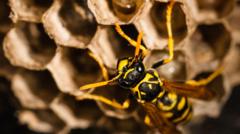Could a Radioactive Wasp Nest Be Hiding at a Former US Nuclear Weapons Site?

A Radioactive Wasp Nest Found at Savannah River Site: What You Need to Know
In a surprising and concerning discovery, a radioactive wasp nest with radiation levels exceeding safety regulations by tenfold was found at the Savannah River Site (SRS) in South Carolina. This facility, which has a storied past of producing parts for U.S. nuclear weapons, has now become the center of scrutiny regarding its handling of radioactive materials. The recent report from the U.S. Department of Energy has shed light on the incident, but it has also sparked criticism from environmental groups and raised questions about the overall safety of the site. This article delves into the details of the incident, its implications, and the broader context of radioactive contamination in the region.
The Discovery of the Wasp Nest
The radioactive wasp nest was discovered on July 3, 2023, by workers who regularly conduct inspections for nuclear radiation at the Savannah River Site. Located near Aiken, South Carolina, this expansive facility spans 310 square miles and has a complex history tied to the Cold War. The nest was found on a post adjacent to where millions of gallons of liquid nuclear waste are stored, raising immediate concerns about potential leaks or contamination. However, federal officials have stated that the contamination of the nest is not linked to a nuclear waste leak.
Understanding Radiation Levels
According to the report released by the U.S. Department of Energy, the radiation levels found in the wasp nest were notably higher than the permissible limits. The report clarified that the wasps themselves would have had significantly lower radiation levels, as they typically do not stray far from their nest—usually a few hundred feet. The report emphasized that the area surrounding the nest showed no signs of contamination, with no impact on workers, the environment, or the public.
Legacy Radioactive Contamination
The source of the radioactive contamination in the wasp nest has been attributed to "onsite legacy radioactive contamination." This term refers to residual radioactivity that persists from the facility's operational days during the Cold War when it was producing plutonium for nuclear weapons. Although the site has shifted its focus to producing materials for nuclear power plants, the remnants of its past operations continue to pose risks.
The Response to the Incident
Following the discovery, the wasp nest was sprayed to eliminate the wasps and subsequently bagged as radiological waste. This action has raised eyebrows among environmental groups and watchdog organizations. Savannah River Site Watch, a group that monitors the facility, expressed frustration over the lack of transparency regarding the origin of the radioactive waste and whether there are any leaks from the waste tanks that the public should be made aware of.
The Implications for Public Safety
The findings surrounding the radioactive wasp nest have highlighted the ongoing concerns regarding public safety in areas with a history of nuclear activity. Although federal officials have assured the public that there was no immediate danger, the incident has reignited debates about the safety protocols and regulations governing such facilities. The Savannah River Site's legacy of producing nuclear materials leaves many questions unanswered about the long-term effects of residual contamination.
The Savannah River Site: A Brief History
The Savannah River Site has a rich and complex history, dating back to its establishment in the 1950s. Originally set up to produce plutonium for nuclear weapons, the facility has undergone significant changes over the decades. Today, it focuses on nuclear material for power generation, but the legacy of its past operations continues to haunt the site. The accumulation of over 165 million gallons (625 million liters) of liquid nuclear waste underscores the scale of contamination that has occurred. Currently, 43 underground tanks are still in use, while eight have been closed.
Environmental Concerns and Criticism
Environmental advocates have voiced strong concerns over the handling of radioactive materials at the Savannah River Site. The discovery of the radioactive wasp nest has only intensified scrutiny of the government's management of such sites. Critics argue that the lack of communication and transparency surrounding incidents of contamination can lead to public mistrust. They emphasize the need for more rigorous safety measures and greater accountability to ensure that similar incidents do not occur in the future.
Regulatory Oversight and Compliance
Regulatory agencies play a crucial role in overseeing the safety and compliance of facilities like the Savannah River Site. The U.S. Department of Energy, along with other environmental regulatory bodies, is tasked with ensuring that radioactive waste is managed safely and effectively. In light of the recent discovery, there may be calls for a review of existing regulations and protocols to address legacy contamination issues and enhance safety measures.
The Future of the Savannah River Site
As the Savannah River Site continues to operate, its future will depend on how well it addresses the challenges posed by legacy radioactive contamination. Ongoing monitoring, transparency, and community engagement will be vital in restoring public confidence. The facility's transition to focus on nuclear power material production offers an opportunity to innovate and improve safety practices, but it must be approached with caution and diligence.
Conclusion: The Road Ahead
The discovery of a radioactive wasp nest at the Savannah River Site is a reminder of the complex legacy of nuclear facilities and the challenges they face today. As federal officials assure the public of safety, the lingering questions about contamination and regulatory oversight remain. Moving forward, it is essential for stakeholders—including government agencies, environmental groups, and the local community—to collaborate in addressing these issues. Ensuring transparency and rigorous safety protocols will be critical in safeguarding public health and the environment as the Savannah River Site continues its operations. How can we better manage the remnants of our nuclear past while ensuring a safer future?
Frequently Asked Questions
What was found at the Savannah River Site?
A radioactive wasp nest with radiation levels ten times above what is allowed under regulations was discovered at the Savannah River Site.
Is the radioactive contamination linked to a nuclear waste leak?
No, investigators have stated that the contamination is not related to a nuclear waste leak and that there was no impact on the environment or public health.
What does "onsite legacy radioactive contamination" mean?
This term refers to residual radioactivity that remains from the time when the site was actively producing parts for nuclear weapons during the Cold War.
What actions were taken regarding the wasp nest?
The wasp nest was sprayed to kill the wasps and was subsequently bagged as radiological waste.
What are the environmental implications of this incident?
The incident has raised concerns about public safety and the management of radioactive materials, highlighting the need for transparency and rigorous safety measures.
As we reflect on the implications of this incident, it's crucial to consider how we can improve safety protocols in facilities with a history of nuclear activity. What steps should be taken to ensure better management of legacy radioactive contamination? #RadioactiveSafety #NuclearContamination #SavannahRiverSite
Published: 2025-08-01 00:54:16 | Category: world



